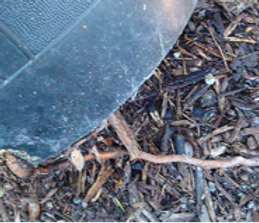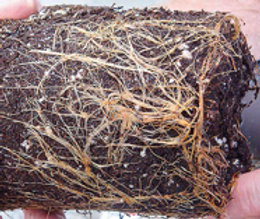It all starts at the bottom

Those of us who love roses are in our own private nirvana every spring when our first blooms burst forth, as fragrant and perfect as they will ever be. It’s enough to make even the most seasoned gardener forget that most of our rose plants’ labors begin under the ground, in an environment we seldom see. To understand how the importance of roots and the soil around them, it helps to know something about their structure. A root is the first thing to emerge from a seed in its quest for life. The first root from a seed is often a taproot that sprouts finer fibers that grow out into the soil. As the plant grows and develops more roots, some of them undergo secondary growth, becoming woody. The main function of these woody roots is to provide a structure to connect the many, finer roots to the plants. These roots branch out and grow away from the plant, producing fine hairs along their length that absorb large amounts of water and nutrients from the soil. Vascular systems that transmit water, nutrients, and manufactured sugars throughout the plant are contained in a root’s plant tissues.
The maturity of the plant and the density of the soil determine the size of the root structure. Still, despite the size of the entire root system, roots are fragile, particularly the fine roots and root hairs that are the major collectors of water and nutrients. New rose plants are especially vulnerable with their limited systems of young, non-woody roots.

Gardeners have to work directly with a plant’s roots when planting or transplanting it. Transplant shock is a result of damage to root hairs that impedes water absorption until the plant can replace them.
Some shock is unavoidable, but it is important to keep the rootball, a clump of soil that contains many of the roots, together when transplanting. It is helpful to cut the plant’s foliage back, giving the roots time to recover and grow before they have to provide water for a plant with lots of leaves.
A rose bush in a pot can develop such a healthy root system that the roots run out of room in the pot and begin to grow around its edges. The plant suffers as the amount of roots takes up space where water and soil should be. Water runs through the pot and the bush seems to wilt quickly. Repot it into a larger pot or take it out of the pot it is in, trim the roots, add fresh soil, and put it back into the same pot.
Conversely, a small, young rose plant will not do well in a pot that is too large. If the proportion of the soil to the new, tender roots is too high, it will hold too much water for the roots to absorb, making them vulnerable to rot. Young roots are easily crushed when potted too early. Give new plants time to develop roots in their small pots before moving them up to the next pot size.
Other things besides planting and transplanting can harm roots. Chemicals in the soil can inhibit root growth. Parasites, such as nematodes that thrive in warm, sandy soils and diseases are a danger, as are the digging and burying habits of animals. Talk to any rosarian with a gopher problem and they will tell you the horror of pushing on a bush and watching it fall over, completely rootless.
What can a gardener do to increase the health of plant roots? Obviously, the soil around the root is of key importance. Friable soil, that is soil that is loose and crumbly, allows space for air and water. These two elements should make up about 50% of a soil’s content so that roots can find space to grow and microbes, worms, and other soil life can flourish. Roots are directed in their growth by the amounts of water, air, and nutrients available for uptake. Roots will stay away from compacted soil and drown in soil that is not well drained. Healthy soil, with a good balance of water, air, minerals, and life forms will result in fast growing, strong roots.
The best way to improve soil texture and drainage is to add compost. Compost consists of naturally decomposed organic materials. Biological organisms break down these materials into a dense, dark mixture that provides carbon and nitrogen amendments to the soil. Serious gardeners often create compost in their backyards while those who lack time and space for such an endeavor can buy it in bags from a store. The product should be loose and dark brown or black in color with no recognizable wood.
Compost should be moist, not soggy, and if it dries to a light brown color, there is probably too much soil and not enough nutrients. Finally, off odors of ammonia or sulfur indicate that the compost has not decomposed enough. Spread compost over the ground surface and it will work its way down into the soil.
Humic and fulvic acids are products that can improve soil health and increase root vitality. These acids are the end products of the microdegradation of plant matter in soils, composts, peat bogs, and water basins. They are not a fertilizer; rather, they improve the soil by strengthening biological activity and increasing water retention. In addition to these benefits, nutrient uptake is improved and chlorophyll synthesis is increased. Finally, humic acid can chelate micronutrients, breaking ionic bonds and increasing their availability in the soil. Increased soil health results in stronger root growth. Humic acid is available in liquid and dry forms from specialty nurseries.
Other amendments that affect soil composition are gypsum, leaf mold, and manures. Gypsum can loosen clay soil by reacting chemically to the soil’s salts. Leaf mold, shredded composted leaves, also loosens soil and provides organic matter. Manures that are composted are high in nitrogen and other nutrients. However, they also contain salts which may add to the saline content of the soil. Too many salts in the soil can actually draw moisture out of plant roots in a reverse osmosis process.
The addition of mycorrhizae to the soil is a controversial topic for gardeners. This group of fungi develops a symbiotic relationship with plant roots; the roots provide the mycorrhizae with food while the fungi extend the reach of the roots for water and nutrients by attaching to the root and extending long strands of mycelium throughout the soil. Initially rose lovers were enthusiastic about mycorrhizae, but further research has dimmed that enthusiasm. Inoculation of mycorrhizae can be expensive and the exact kind of mycorrhizae that work best with roses is uncertain. Perhaps most illuminating is the research that indicates that the major nutrient a plant gains through mycorrhizae’s increased root capacity is phosphorus. If a plant has enough phosphorus, it doesn’t send out the signals that encourage symbiotic mycorrhizal growth. Adding phosphorus in fertilizer may negate the benefits of any inoculation. Is there a rose lover anywhere who can swear he will never use phosphorus again in fertilizing roses? The money for mycorrhizae would be better invested in a garden wide application of humic acid.
Finally, protect your rose bushes’ roots with a nice two to three inch layer of mulch. This will keep the roots cool and slow down the growth of water stealing weeds. Any roots too close to the soil surface will be cushioned against surface injury. Enjoy the blooms of spring, but don’t forget what lies beneath!




























































